Pienza, the Ideal City of the Renaissance, is undoubtedly one of Tuscany’s hidden gems. While it never reached the levels of a big city -and there’s a reason for that- Pienza is a must-see for your Italian road trip. Standing quietly in the valley of Val d’Orcia, Pienza appears at first glance like a sleepy little town. However, even though it has only 2,000 inhabitants, its importance exceeds its size. In order to understand its significance, we have to travel almost 600 years back in time.
In the following lines of this Pienza travel guide, you will find everything you need to know before you visit it. Specifically, I will analyze why this Italian town played a cornerstone role during the Renaissance and why it’s a prototype for modern urban planning. Moreover, I’ll share the best things you can do in Pienza, accompanied by several photos. Last but not least, you’ll find a selection of places to stay in Pienza together with the optimal ways to include it in your Tuscany road trip itinerary.
So, let’s start with the travel guide to Pienza.
*Some of the links are affiliate links. It means that if you buy something, I might earn a small commission at no additional cost to you.
Pienza travel guide: Facts about Pienza and the Ideal City concept
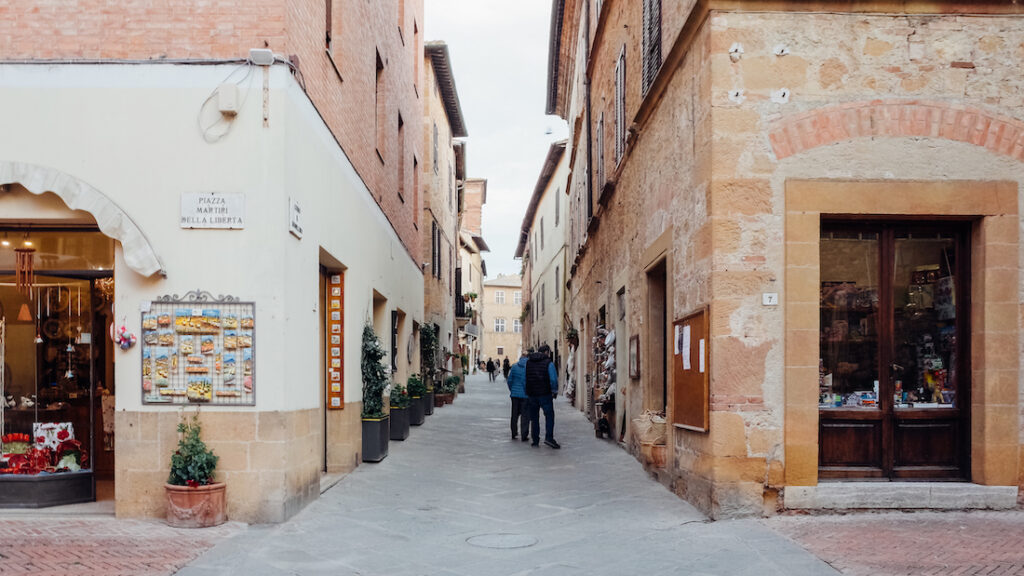
Before writing about the main attractions of this little Italian town, I believe that some historical information is worth mentioning. The background information will help you gain a deeper insight into Pienza’s importance.
Who is the man who transformed Pienza?
Before the Renaissance, Pienza’s name was actually Corsignano. However, during the 14th century, the Piccolomini family obtained significant parts of Corsignano. The Piccolominis were a noble family from Siena that remained powerful for almost five centuries (13th to 18th). One of its more prominent members was born in Corsignano in 1405, named Enea Silvio Piccolomini.
Enea was actually the man who changed Pienza’s fate forever. In August 1458, Enea Silvio Piccolomini became Pope under the title Pope Pius II. A Renaissance humanist, Pius II was a highly admired poet in his era, even though his most famous work is his autobiography called Commentaries.
Pius II remained a Pope until he died in 1464, six years after his inauguration. One of the projects that he focused on during his reign was the redesign of Corsignano. Devoted to the humanism of the Renaissance, Pius II decided to engage in a progressive urban project: he decided to build an ideal city.
How long did it take to build Pienza?
As one can easily imagine, redesigning and building a city from scratch requires a massive effort. However, more than 20,000 people worked on the project, and the town took just three years to complete. Specifically, the project kicked off in 1459, and by 1462, everything was ready.
Bernardo Rossellino, an architect who worked with Leon Battista Alberti, carried out the rebuilding of Corsignano. The latter was one of the most notable persons of the Italian Renaissance, who built the façade of the Palazzo Rucellai in Florence. Rossellino’s name has its own spot in front of Pienza’s Duomo, in a beautiful well called the “well of dogs.” Pius II consecrated the Duomo in the last days of August 1462.
Where does the name come from?
Of course, some sense of vanity doesn’t come as a surprise in every project of such scale. The new town had to change its name. It wasn’t Corsignano anymore. Instead, it was renamed Pienza, which means “city of Pius.”
What makes Pienza an ideal city?
The concept of the ideal city is a crucial element of Renaissance architecture. In brief, we can say that it marks the transition from verticality -seen in the Middle Ages architecture- to horizontality. That said, what is evident in Pienza is the sense of perspective that offers open space to the inhabitants. The buildings have fewer floors, and therefore the town appears more horizontal.
Moreover, one of the cornerstone elements is the big square, where life unfolds. The idea is that around the main square, a harmonic settlement appears. In general, symmetry is the heart and soul of the ideal city concept. When you visit Pienza, you will be impressed by the buildings around Duomo. However, a closer look will give you even more details. For example, the square is full of stone seats attached to the buildings. That’s where the citizens could sit and socialize. That’s a concept that we take today for granted, but it was avant-garde back in the day.
Of course, we should mention here that even though Pienza had an anthropocentric approach, it was also planned as a retreat from Rome. Thus, one can still see palazzos and other notable buildings destined for the most important citizens of the era.
Why didn’t it reach its full potential?
Despite becoming a role model for other Italian cities soon and eventually for many European ones, Pienza never reached its full potential. But as I wrote at the beginning of this travel guide to Pienza, there’s a reason for that—or, actually, more than one.
First of all, Pope Pius II’s death in 1464 also meant the end of the project. There were plenty more things to build in Pienza; however, the Pope’s death halted the project. That said, today, we see how Pienza was when he died and not how it could have been. The latter, we have to imagine.
Moreover, in the coming century, Pienza was occupied several times. In 1502 the Borgias occupied it, in 1530, the same happened by Charles V, and by 1559 it was the time of the Medici family to take it over. And then, it was Pienza’s location. Located in the Val d’Orcia, the town was too far away from the major urban centers and the main transportation hubs.
That said, Pienza has remained a small provincial town in Tuscany ever since. It’s a pity its significance didn’t grow, but that’s probably why Pienza is still so well-preserved without being altered at all.
Pienza travel guide: The main sights
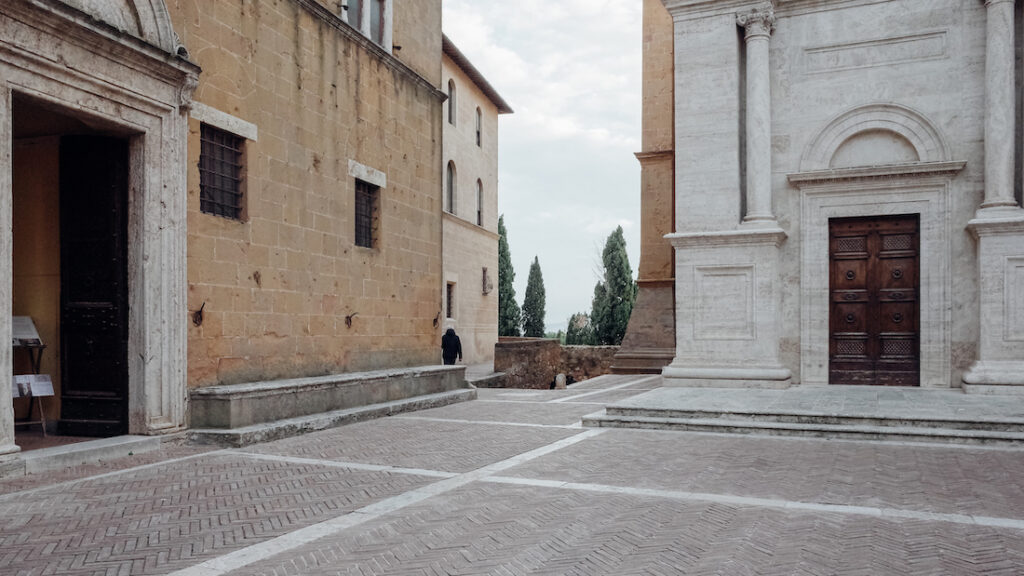
Today, Pienza is a UNESCO World Heritage Site, and most of its monuments remain intact. You can see them all in a short walk, and you won’t need more than a couple of hours. However, I believe it’s better to spend at least one night in Pienza and let yourself immerse in its atmosphere. At the bottom of this post, you’ll find the best places to stay in Pienza.
As for the things to see in Pienza, these are:
At the Piazza Pio II (Main Square)
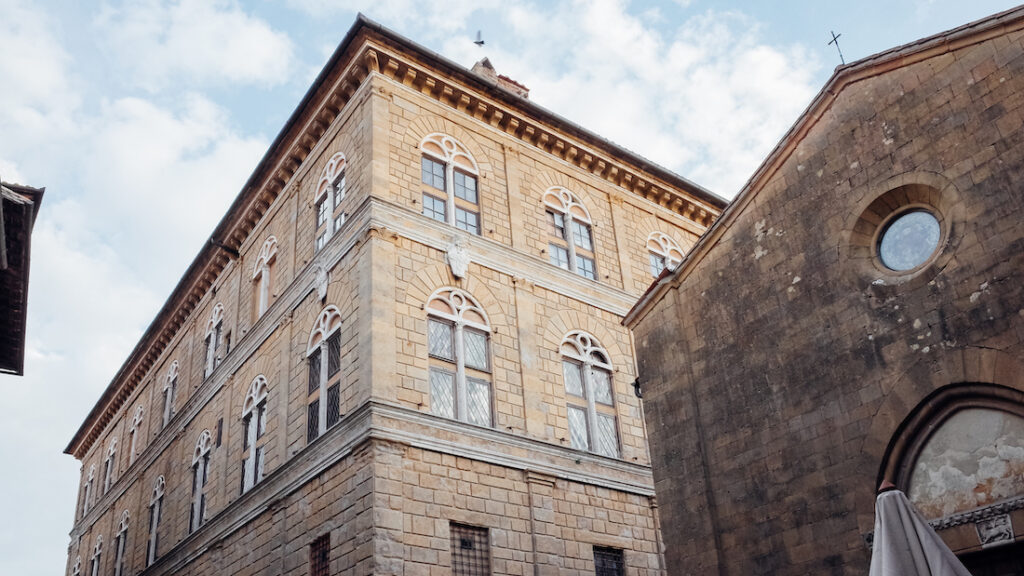
The Duomo – Cathedral of Santa Maria Assunta
Known also as Cattedrale dell’Assunta, the Duomo stands in the heart of the main square. The cathedral’s travertine facade is truly a masterpiece. However, despite being one of the earliest examples of Renaissance architecture, it has a German touch. Specifically, the bell tower has the design of a so-called Hallenkirche. There’s probably an explanation for that: Pius II served for several years in Germany before becoming Pope.
The Palazzo Piccolomini
That’s probably the most beautiful structure in the main square. Architect Rossellino imitated here the design of Palazzo Rucellai in Florence. The palazzo enjoys a stunning view over the Val D’Orcia, and it also has a barn for up to 100 horses. In front of it, you can see the well of dogs.
You can visit the Palazzo Piccolomini and walk through its rooms and gardens. There’s an entry fee, but you can book your ticket in advance here to skip the queue.
Palazzo Vescovile or Palazzo Borgia
That’s where the Diocesan Museum is. The collection hosts mainly examples of local textiles and paintings. It occupies eleven rooms, and everything appears in chronological order.
Palazzo Comunale
That’s the town hall, and it’s actually one of the latest additions to the square. A notable element is its brick bell tower, which is shorter than the one in the Cathedral. The reason for being shorter is to mark the superiority of the Church’s power.
Beyond the Piazza Pio and around Pienza
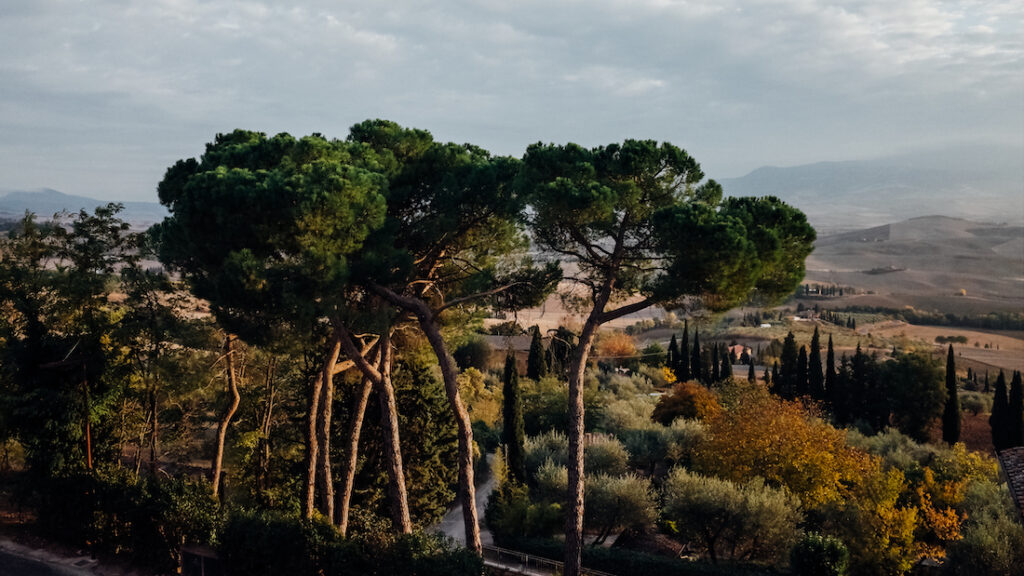
Take a short walk through the old town, following the Corso il Rossellino, where you will admire the town’s beautiful architecture. Then, wander through the alleys and follow the smaller streets: most of them will lead you to breathtaking viewpoints. Each of these spots feels like a painting.
A short walk outside of Pienza will also lead you to the Romanesque church of Pieve di Corsignano, where Pope Pius II was baptized.
And, of course, don’t miss the chance to explore further the stunning Val d’Orcia. Pienza is a fantastic base for your journey around the valley (and Tuscany), so stay a couple of days here. Exploring the wonderful Val d’Orcia is a must if you happen to be in the region. Don’t miss it.
Last but not least, not everything is about sightseeing. Apart from enjoying a local meal, make sure to have a drink at Idyllium. Straight behind the main square, Idyllium’s terrace has probably the best viewpoint toward the valley. However, it tends to be packed outdoors; therefore, either book a table in advance or try to be there not in rush hour. Great cocktails and stunning views of the valley -what’s more to ask?
Unique things to do in Pienza, Italy
Two of the most special things to do in Pienza have to do with cheese. More specifically, with pecorino.
The Pecorino of Pienza is made from sheep’s milk, and it’s delicious. Throughout the old town, you’ll find loads of shops selling different varieties of local pecorino. Their taste largely depends on the pecorino’s age, and you can also buy other local products like wine or pici (handmade pasta).
And yes, there’s another thing to do in Pienza that has to do with pecorino. However, you should plan your visit because that’s one of the rare occasions that the town is packed. That’s the Fiera del Cacio, a local festival dedicated to -what else- pecorino. It usually takes place in early September during a weekend. Apart from the folklore, you can try all sorts of this famous local cheese.
Two fun facts about Pienza
#1 Pienza’s street names keep their romantic character intact. While walking through its beautiful streets, you will come across street names like Via dell’Amore (Love Street), Via del Bacio (Kiss Street), or Via della Fortuna (Good Luck Street).
#2 Did you know that despite its compact size, Pienza appears in several famous movies? Among them are Romeo and Juliet (1968) by Franco Zeffirelli, Nostalghia (1983) by Andrei Tarkovsky, and The English Patient (1996) by Anthony Minghella.
Practical info for your visit to Pienza
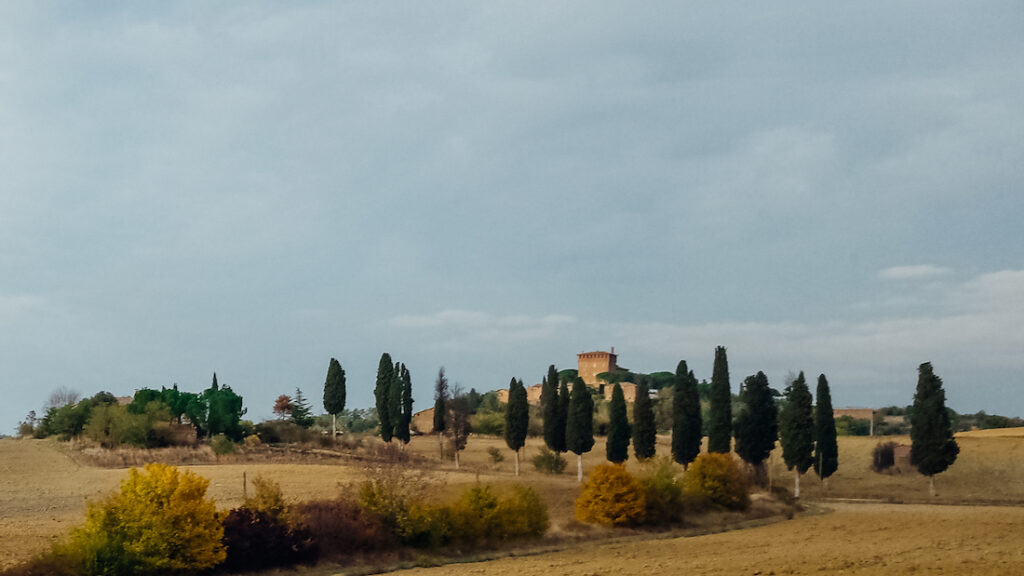
If you’re not visiting Pienza on an organized tour, you’ll probably reach the town in your car. The latter is perhaps the best option because you’ll have the chance to drive through the picturesque Val d’Orcia. However, you need to know that parking is prohibited inside the old town. You’ll have to park your car in one of the several parking lots outside the walls.
If you’re looking to rent a car for your road trip to Tuscany, check out Rental Cars. That’s the best website, combining the largest car companies; they’ll help you find the best prices for renting a car in Italy. It’s the service I always use in my journeys, and it never let me down. Rent a car for your Italian journey here.
How to reach Pienza on your own
If you are starting from Florence, you will need approximately one and a half hours to reach Pienza (116 km/72 miles). The route is not that scenic since the biggest part is through the motorway.
On the other hand, it’s faster to reach Pienza from Siena. It takes approximately 50 minutes (60 km/37 miles), and the road is more beautiful.
How to visit Pienza on an organized tour
If you don’t have a car, the best option is to visit Pienza on an organized tour. Several tour operators offer a variety of day trips from nearby cities, and they usually include wine tasting. Most of them combine the visits to Pienza with other picturesque towns/villages like San Gimignano or Montepulciano.
The best day trips to Pienza are:
From Florence
On a day trip starting from Florence, you can visit both Pienza and Montepulciano. In addition to seeing the two towns, this tour offers excellent wine tasting in both places. Check out the tour from Florence here.
From Siena
Similar to the one above, this day trip to Pienza and Montepulciano starts from Siena. Wine tasting is included in the price, and it lasts slightly less than the one from Florence because Siena is much closer. See the prices and availability for the tour from Siena.
From Florence or Siena (more flexible)
If you want to remain flexible regarding your starting point, you can book a private tour from either Florence or Siena. Of course, it comes at a price, but this private tour will drive you to both places. You’ll visit three wineries and have lunch. Check the tour from either Florence or Siena here.
Where to eat in Pienza

Despite its small size, Pienza has plenty of good local restaurants. If you stay just a day or two you won’t have the chance to visit them all; therefore, I’ll add here three of the best places to eat in Pienza. These are:
- At Trattoria La Chiocciola, you’ll feel at home, and you’ll taste the local cuisine.
- On the other hand, at Ristorante Il Rossellino, you’ll enjoy spectacular views and a more upscale meal.
- Finally, at Sperone Nudo, you’ll have a superb selection of Tuscan food.
Where to stay in Pienza: the best hotels
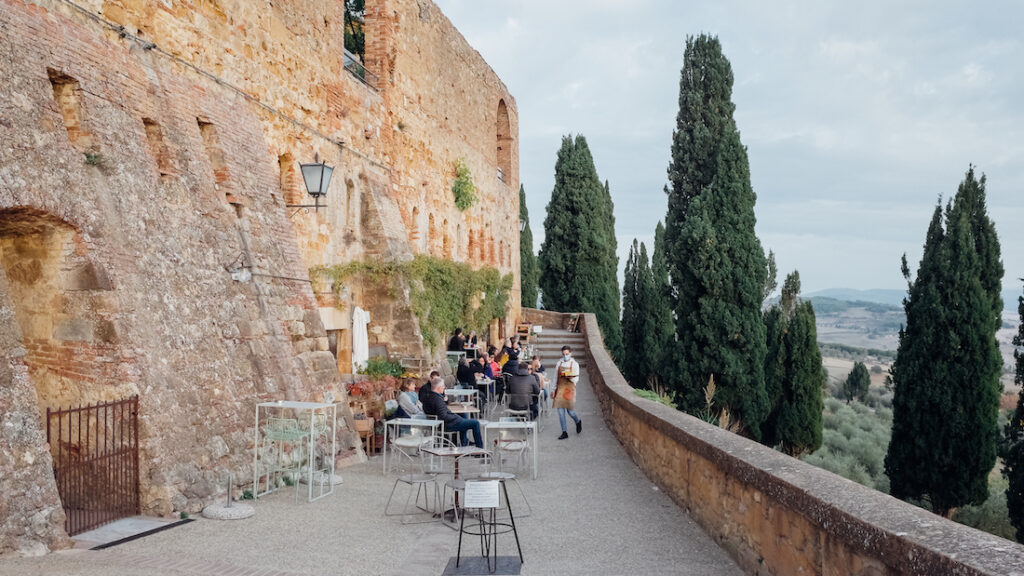
Exactly like with the food options above, Pienza has a wide selection of excellent accommodations for its size. That said, you can find reasonable options but also boutique hotels. As I already wrote, I highly recommend spending at least one night in Pienza. The Val d’ Orcia is Tuscany’s most beautiful region, and you can very well call home Pienza for a couple of days. From there, you can explore the whole area and even visit nearby cities like Siena or even Florence.
So, here you can find the best hotels in Pienza.
Best hotels in the historical center of Pienza
La Bandita Townhouse. Hands down the best option for your nights and days in Pienza. The hotel offers modern interiors and a fantastic breakfast. It comes at a price but if it’s okay for you to splurge, then book your room. See the prices and availability for the fantastic La Bandita Townhouse here.
Il Giglio. Il Giglio B&B is one of the best options for your stay in Pienza. It is located in a Renaissance building in the town’s center. The rooms are stylish, with terracotta floors and antique furnishings. See the Il Giglio here.
Il Giardino Segreto. Situated in the historical center of Pienza, Il Giardino Segreto (The secret garden) is in a restored building of the 18th century. Its wonderful inner garden, where all the rooms face, is one of its most charming elements. Check here the Il Giardino Segreto.
La Bellavita B&B. Another accommodation option in the town’s heart is La Bellavita, a beautiful B&B that is one of the best places for couples. See the Bellavita here.
Casa Dolce Casa. In the heart of Pienza’s historical center, the Casa Dolce Casa is one of the simplest yet most beautiful accommodations. The rooms have their charm even though they aren’t anything near luxurious. See prices and availability for Casa Dolce Casa here.
La Città Ideale Suites. Last but definitely not least, La Città Ideale Suites is a historic building at the edge of the old town. Its rooms come with wood-beamed ceilings and terracotta floors. See here the La Città Ideale Suites.
Best hotels straight out of Pienza (Val d’Orcia)
Piccolo Hotel La Valle. Just 150 meters outside of Pienza, the Piccolo Hotel La Valle is a beautiful option for your stay. It has a roof garden and spacious rooms. See the Piccolo Hotel here.
Hotel San Gregorio. Here’s one more option straight out of town. The San Gregorio is located in a former theatre, just 50 meters from the historical center and near the Val d’Orcia Natural Park. It features a large private courtyard and serves a delicious Tuscan breakfast daily. See the San Gregorio here.
Agriturismo Il Colombaiolo. Half a kilometer out of Pienza, this is an excellent option for nature lovers. It is housed in a 15th-century building in the middle of a big vineyard. Is there really anything more to ask? See the Agriturismo Il Colombaiolo here.
Poggio ai Gelsi. Pretty similar to the previous accommodation, Poggio ai Gelsi offers beautiful rooms and stunning views of the Val d’ Orcia. There’s also a swimming pool, and each room comes with a kitchen. See the Poggio ai Gelsi here.
Please use the interactive map below for all other accommodation options in and around Pienza.
Pienza guide: Conclusion
Although Pienza never reached its full potential, it left a solid mark in world history. It’s an impressive achievement that a city that took just a few years to build became the prototype for the majority of contemporary cities. I was truly mesmerized by the looks of the little Italian town and seeing where modern urban planning initiated made a lasting impression on me. Yes, there might be just a few things to do in Pienza, but all of them are equally unique.
Due to pre-planning, I only had a full day in Pienza. However, I promised myself that whenever I returned to this stunning side of Italy, I would spend more days in town. Pienza is one of those cities that deserve to be discovered step by step and stone by stone. In addition, its elegance is mesmerizing, and despite its size, you won’t feel bored. Road trips can often be tiring, and spending a night or two in a quiet place is both refreshing and rewarding.
Long story short, Pienza is a hidden gem in Tuscany’s most beautiful valley. Don’t miss the chance to visit it: you’ll feel like walking in an open-air museum that is still vibrant, charming, and elegant.
More Italy: San Gimignano, Taormina, Catania, Florence, Venice
Pin it for later
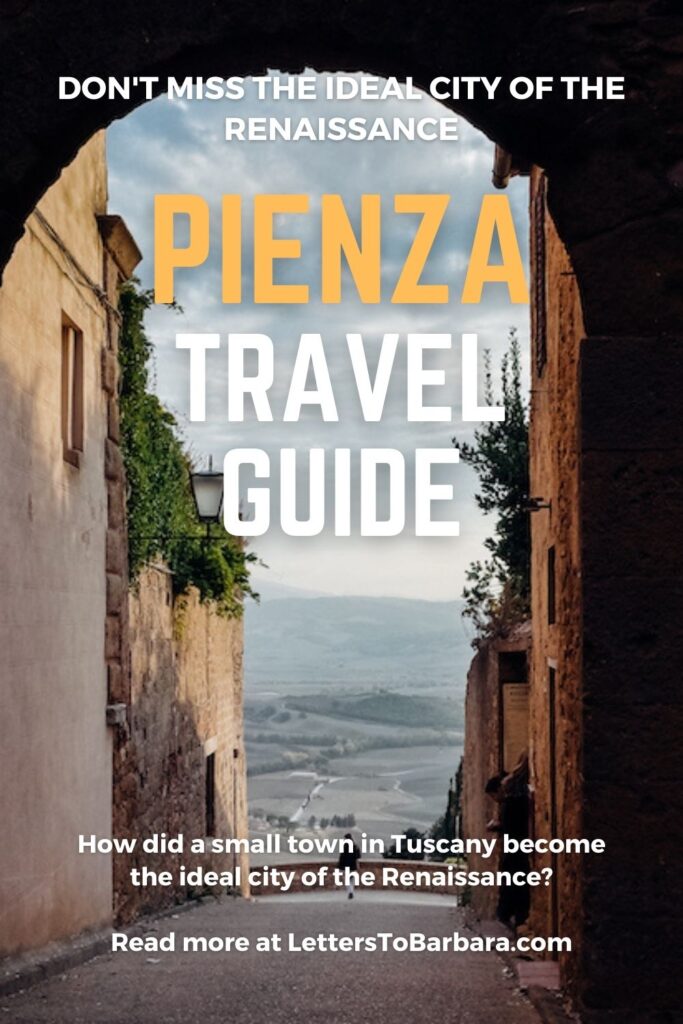
Sharing is caring. Share this Travel Guide to Pienza with your friends.
Last Updated on March 22, 2024 by George Pavlopoulos

